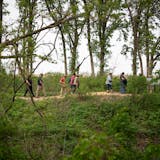The Southwest light-rail line cleared a critical hurdle Wednesday that will allow construction to begin on the $2 billion project this winter.
The Federal Transit Administration (FTA) has notified the Metropolitan Council that it will likely pay for close to half the cost of the nearly 15-mile line linking downtown Minneapolis with Eden Prairie — the biggest public works project in state history.
Passenger service could start in 2023.
The FTA's notice means the Met Council can begin spending local money to start the project with the expectation that federal money will be available later for reimbursement. The notice, called a "letter of no prejudice," is usually a sign that the entire $929 million federal grant will be forthcoming.
"This is a big moment," said an ebullient Alene Tchourumoff, chairwoman of the Met Council at a news conference Wednesday. "This is two decades of work."
Tchourumoff was joined by outgoing Hennepin County Commissioner and longtime transit advocate Peter McLaughlin, who said: "This is a day we've been waiting for for a long, long time. It's hard to overstate the action today."
Without federal help, it's unlikely the Southwest line could be built. So far, some $293 million in state and local money has been used to pay for design and engineering.
The Met Council is expected to award the $799 million construction bid Thursday to Lunda/C.S. McCrossan, the only firm left after the bidding process dragged on for more than a year.
![Three weeks ago, Octavio Rodriguez switched from making transmission parts to casting parts for hospital bed brake assemblies at Twin City Die Castings. ] GLEN STUBBE • glen.stubbe@startribune.com Thursday, April 9, 2020 How employee-owned Twin City Die Casting, which just laid off 40 production workers of its 250 employees in what was supposed to be a good year, is trying to accelerate its pivot to growing medical parts business for ventilators, hospital beds, etc as it copes with instan](https://arc.stimg.co/startribunemedia/WNZYKGTZ5IYMUCO3KI5TR3N7WI.jpg?&w=80&ar=1:1&fit=crop)
djoles@startribune.com As boaters flock to Minnesota lakes and rivers this holiday weekend for the unofficial kick-off to the boating season, they'll face more inspections in and out of the water as local cities and counties ramp up their work to stop the spread of invasive species. Across the metro, more boat accesses will be staffed by watercraft inspectors thanks to $10 million funneled to county government programs this year, up from $4.5 million the state allocated last year. ORG XMIT: MIN1505222156290209 ORG XMIT: MIN1506021218440580](https://arc.stimg.co/startribunemedia/34QSKO44B2XKVNUZCO5SLJQSLY.jpg?&w=80&ar=1:1&fit=crop)

